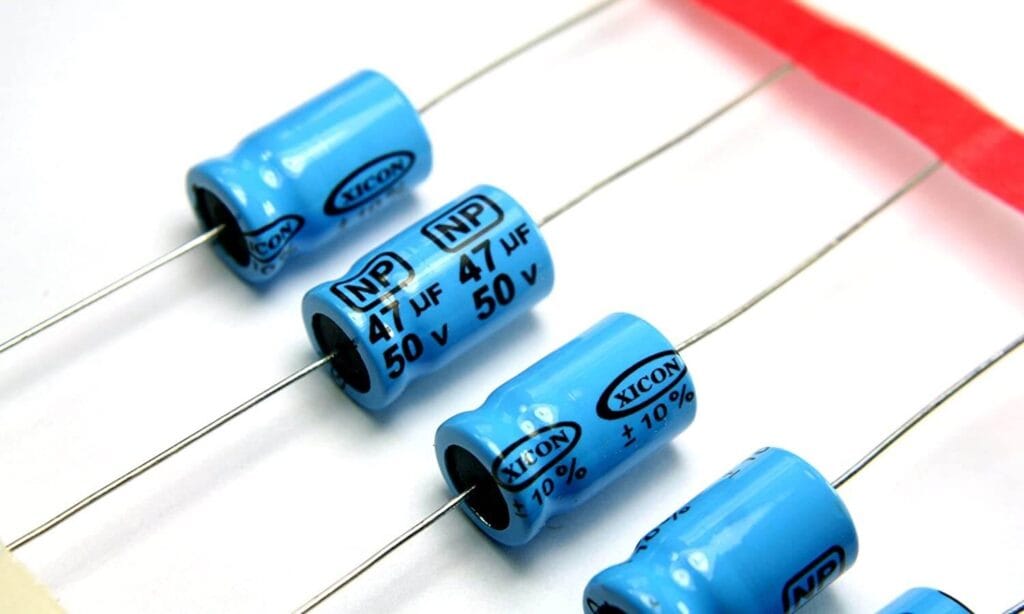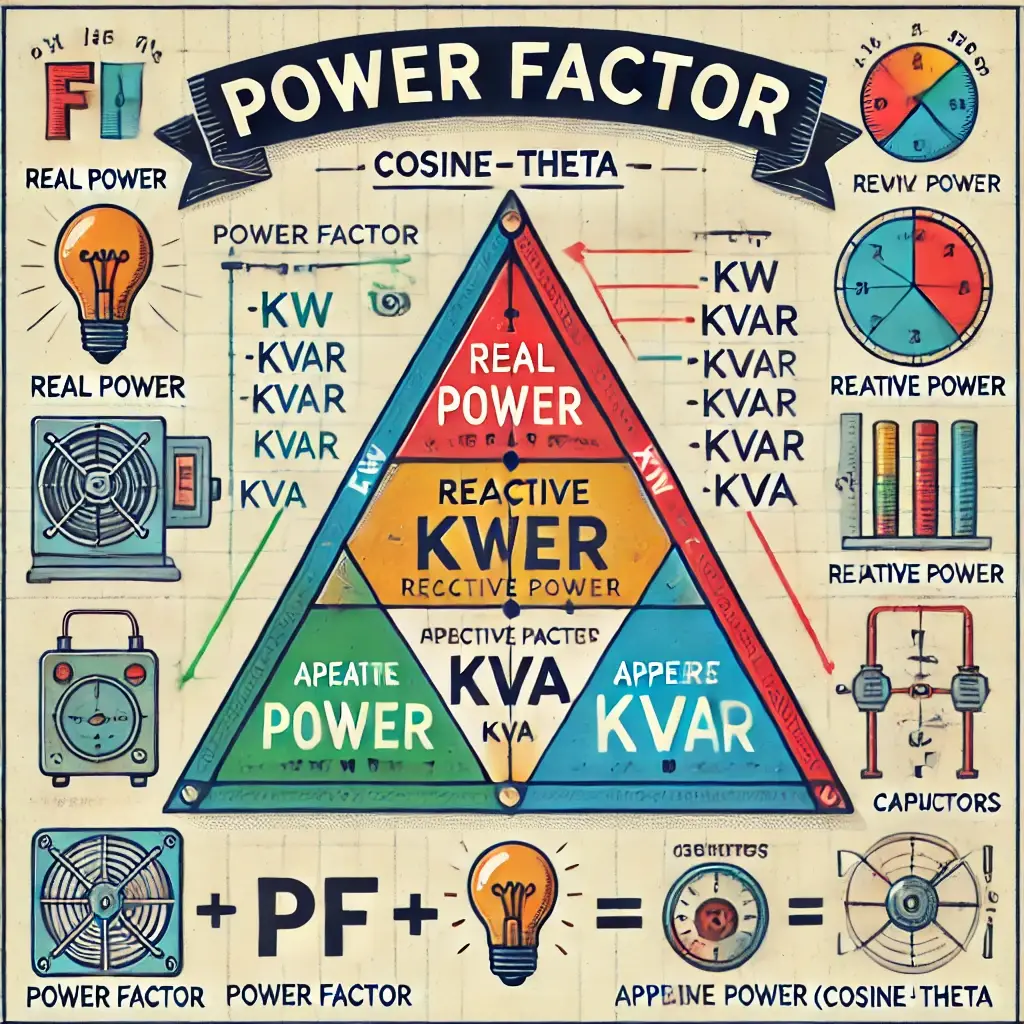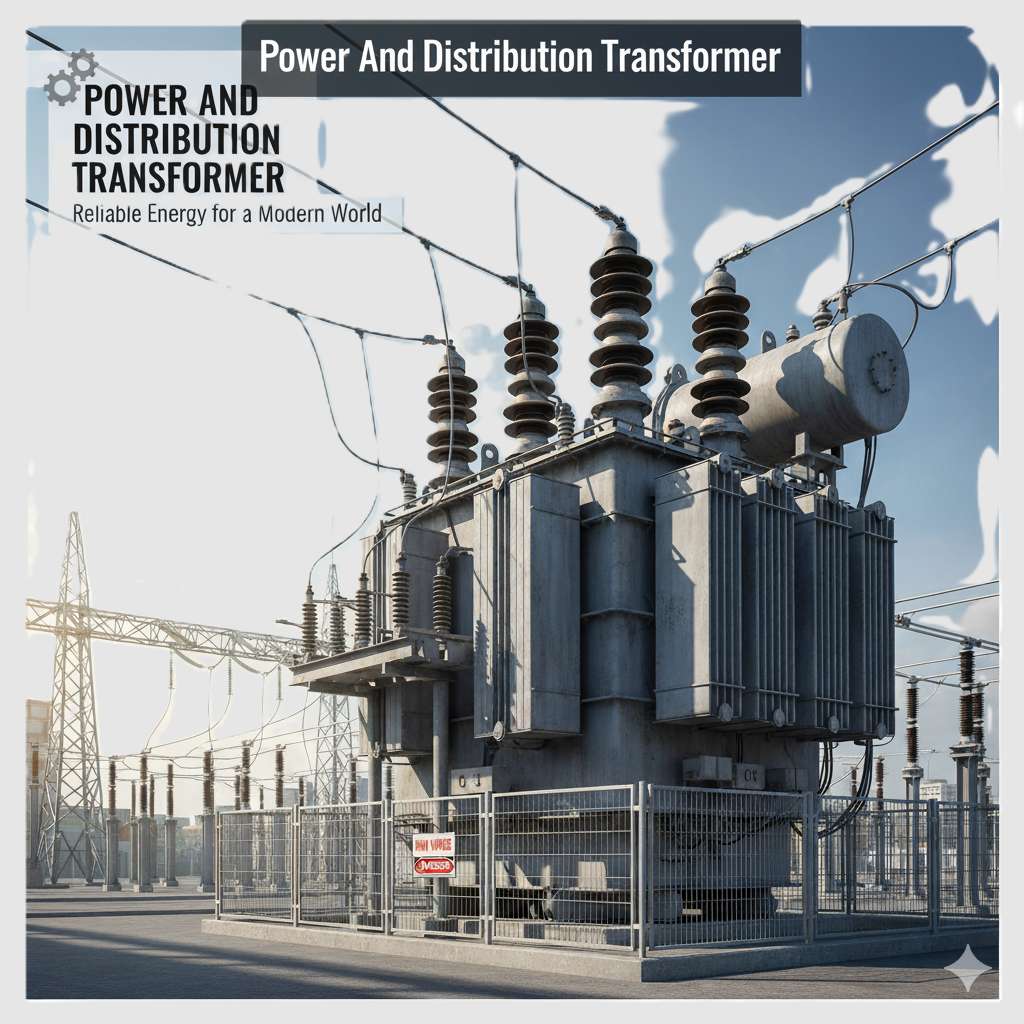Table of Contents
Non-Polarized Capacitors
A capacitor is a small but very useful part used in many electrical and electronic devices. It has two ends (or terminals) and its main job is to store energy in the form of electricity. Think of it like a tiny battery that can charge and discharge quickly.
Capacitors come in different shapes, sizes, and types depending on where and how they’re going to be used. Inside a capacitor, there are two plates made of metal. These plates are separated by a material called a dielectric, which doesn’t let electricity pass through it but helps store the energy.
Now, capacitors can be grouped in many ways—like by their size, shape, what they’re made of, and whether or not they have polarity (a positive and a negative side).
When we talk about polarity, there are two main types of capacitors:
- Polarized capacitors
- Non-polarized capacitors
Let’s focus on non-polarized capacitors.
What is a Non-Polarized Capacitor?
A non-polarized capacitor is a type of capacitor that does not have a positive or negative side. This means you can connect it in any direction in a circuit, and it will still work properly.
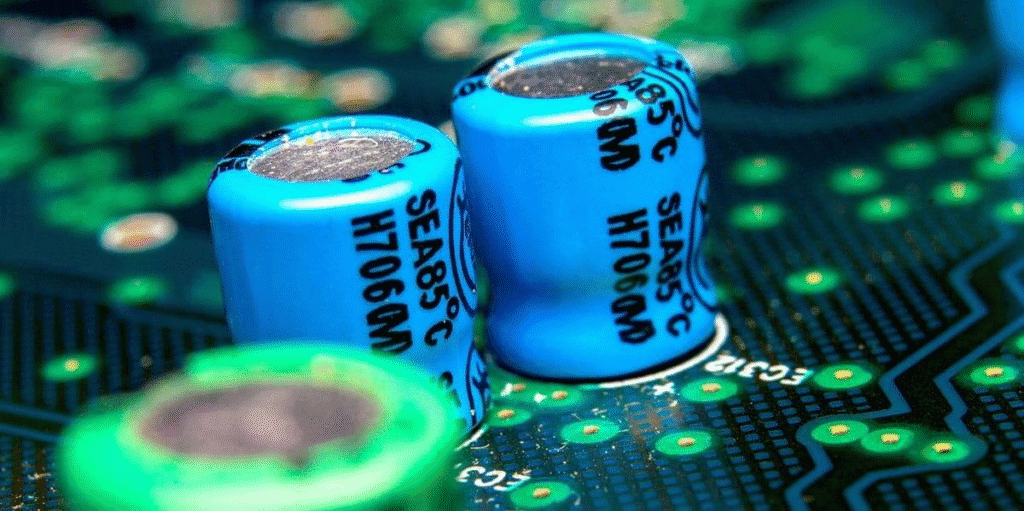
Unlike polarized capacitors (which must be connected the right way around), non-polarized capacitors are flexible and safe to use in either direction. That’s why they are very useful in circuits where the current changes direction, like in AC (alternating current) systems.
You can even use a non-polarized capacitor in place of a polarized one, as long as it matches the correct size, strength, and voltage your circuit needs.
In simple words, a non-polarized capacitor is like a helper in your circuit that doesn’t mind which way you put it in—it just does its job quietly and safely.
This makes it a very useful and reliable part in many types of electronic devices.
Types of Non-Polarized Capacitors
Non-polarized capacitors come in different types. Each type has its own use and unique features.
Ceramic Capacitors
Ceramic capacitors are one of the most common types of non-polarized capacitors. You will find them in many electronic devices because they are small, reliable, and work really well.
In the past, these capacitors were round like a small disk. Today, most of them are shaped like tiny blocks. Even though they look different, they still do the same job—helping electricity flow the right way in a circuit.
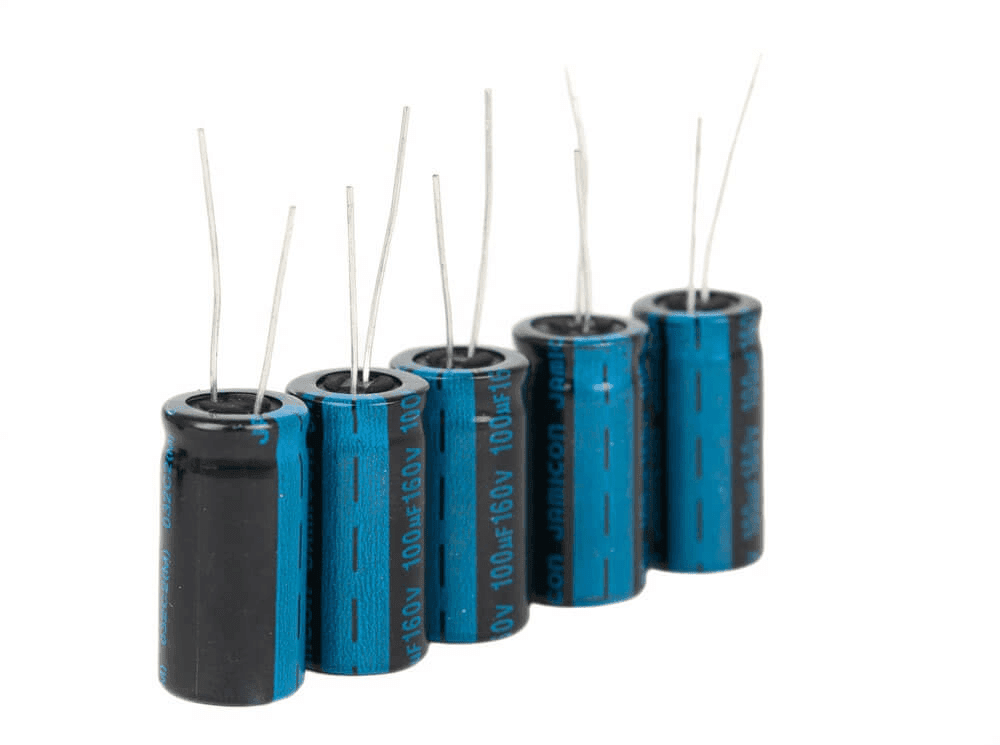
These capacitors are great for things that need low energy loss and stable performance. They can handle changes in temperature, voltage, and frequency without losing their accuracy. That’s why they are trusted for giving steady and correct results every time.
Ceramic capacitors are tiny electronic parts that play a big role in helping circuits work properly. You’ll often find them used in RF (radio frequency) circuits because they perform really well there. They come in many sizes, starting from as small as 10 picofarads (pF) and going up to 1 microfarad (μF).
Silver Mica Capacitors
Silver mica capacitors are small but vital in electronics. They consist of thin layers of natural mica, coated with silver on both sides. These layers are stacked and sealed with a strong epoxy coating. This coating protects them from heat, moisture, and harsh conditions.

They may not be the most common type of capacitor, but they are definitely one of the most reliable. Why? Because they are very stable, even when the temperature changes. That makes them perfect for sensitive jobs where precision matters.
These capacitors are often found in circuits that require steady performance. For example, they excel in filters, oscillators, and amplifiers. They are also good for high-voltage applications, like radio transmitters, inverters, and tuning circuits.
Silver mica capacitors come in a wide range of values, usually between 47 pF to 3000 pF, and they can handle voltage from 100 volts all the way up to 10,000 volts. Unlike some other types, like ceramic capacitors, silver mica types leak very little energy and keep their value over time.
Polyester Capacitors
Polyester capacitors, also known as Mylar capacitors, are a type of electrical component used to store small amounts of energy. They are made using a plastic material called PET (polyethylene terephthalate), which is strong, flexible, and works well in many environments.
These capacitors can be built in two different ways: using layers of film and foil, or with a special metalized film. Both designs help them work efficiently.

One of the biggest advantages of polyester capacitors is that they are affordable and reliable. They don’t leak much energy and they offer good accuracy for many everyday uses. They usually come in sizes from 0.001 microfarads (uF) to 50 uF, which makes them useful for many electronic projects where extreme accuracy isn’t required.
These capacitors are also moisture-resistant, which means they can work well even without a protective coating. They are known for their strong insulation and high efficiency in a compact size.
However, one thing to keep in mind is that their capacitance can change more with temperature compared to some other types of capacitors. Still, they can handle temperatures up to 125°C, which is more than enough for most uses. They can also work at voltages up to 60,000 volts (60 kV) and usually come with a tolerance range of 5% to 10%.
Polystyrene Capacitors
Polystyrene capacitors are a type of film capacitor known for being very accurate and having very low leakage. This means they don’t lose much energy and can hold their charge really well.
Because they are so reliable and stable, they are often used in places where accuracy really matters—like in filters or circuits that need steady performance over time.

These capacitors are usually made in a small, tubular (cylindrical) shape. In some cases, if needed, polyester film capacitors can be used instead of polystyrene ones.
The value range of these capacitors goes from 10 picofarads (pF) up to 1 microfarad (μF). They work best at normal temperatures and can handle heat up to around 85°C without changing their performance. In fact, their capacitance (the amount of charge they can hold) stays almost the same as long as they are within this temperature range.
Polystyrene capacitors are commonly used in low-frequency and low-temperature electronic applications. They are a great choice when you need something simple, stable, and accurate.
Polycarbonate Capacitors
Polycarbonate capacitors are known for their excellent quality and high accuracy. They are a bit more expensive than regular capacitors, but they make up for it with their long life, low leakage, and great performance even in tough conditions.

These capacitors are very reliable and work well in both high temperatures and harsh environments. You’ll usually find them in sizes ranging from 100 picofarads (pF) to 20 microfarads (µF).
What Makes Them Special?
The key material used inside these capacitors is polycarbonate, a strong and stable plastic. This material is used either as a film or with a metal coating. Thanks to this, polycarbonate capacitors are:
- Very stable
- Low in energy loss
- Highly accurate
- Strong and durable
They keep working perfectly from -55°C to +125°C, making them a great choice for devices that must handle extreme heat or cold.
Why Choose a Polycarbonate Capacitor?
These capacitors are best when:
- You need stable performance across changing temperatures.
- You want low energy loss, especially in sensitive circuits.
- You’re working in difficult environments like factories or outdoor equipment.
- You need precise timing or filtering, such as in communication devices or advanced electronics.
Polypropylene Capacitors
Polypropylene capacitors are a special type of capacitor that use a plastic-like material called polypropylene as their core part, known as the dielectric. This material helps them store and release electrical energy in a very stable and reliable way.

These capacitors come in two main types: film and foil or metalized. Their sizes can vary widely — from very small (100 pF) to quite large (50 µF), depending on how much energy they need to handle. One of their best features is their accuracy. They don’t lose much energy over time, and they stay steady even when conditions change.
Why Use Polypropylene?
Polypropylene is strong and doesn’t get damaged by moisture like some other materials do. That means these capacitors don’t need extra coatings or protection. They also don’t change much with temperature or frequency, which makes them very dependable. However, they are most effective up to a frequency of 100 kHz and can work safely up to a temperature of around 105°C. Some of these capacitors can even handle voltages as high as 400 kV.
Where Are They Used?
Polypropylene capacitors are used in many different areas. You’ll find them in small electronic parts like voltage-controlled oscillators and signal holding circuits. They’re also used in bigger, high-power tasks like induction heating. On top of that, they help improve power use in systems by correcting the power factor and running AC motors smoothly.
In Simple Words
If you’re looking for a capacitor that is strong, steady, and works well in both small and big tasks — even when things get a bit hot or noisy — polypropylene capacitors are a smart choice. They last long, perform well, and need very little extra care.
Teflon Capacitors
Teflon capacitors are a special type of capacitor that use a material called PTFE (Polytetrafluoroethylene) as their insulator, also known as the dielectric. This material is strong, stable, and reliable, which makes these capacitors very useful in many important areas.
These capacitors come in two types: metalized and foil (or film). Both types are known for their accuracy, long life, and very low leakage, which means they don’t lose charge easily. This makes them a great choice for applications where precision really matters.
Teflon capacitors can work in a wide range of values, from as small as 100 picofarads (pF) up to 1 microfarad (µF).
One of the biggest advantages of these capacitors is that they can handle very high temperatures—up to 200°C—without losing performance. Even though they are a bit more expensive and slightly larger than other types, their high reliability makes them worth it, especially in critical uses.
Because of their strength and stability, Teflon capacitors are often used in military and aerospace equipment, where performance must be perfect even in extreme conditions.
Glass Capacitors
Glass capacitors are very strong and tough. They can work well even in very harsh or rough conditions. These capacitors are stable, which means they keep working reliably over time. They usually come in small sizes, with values between 10 picoFarads (pF) and 1000 pF.
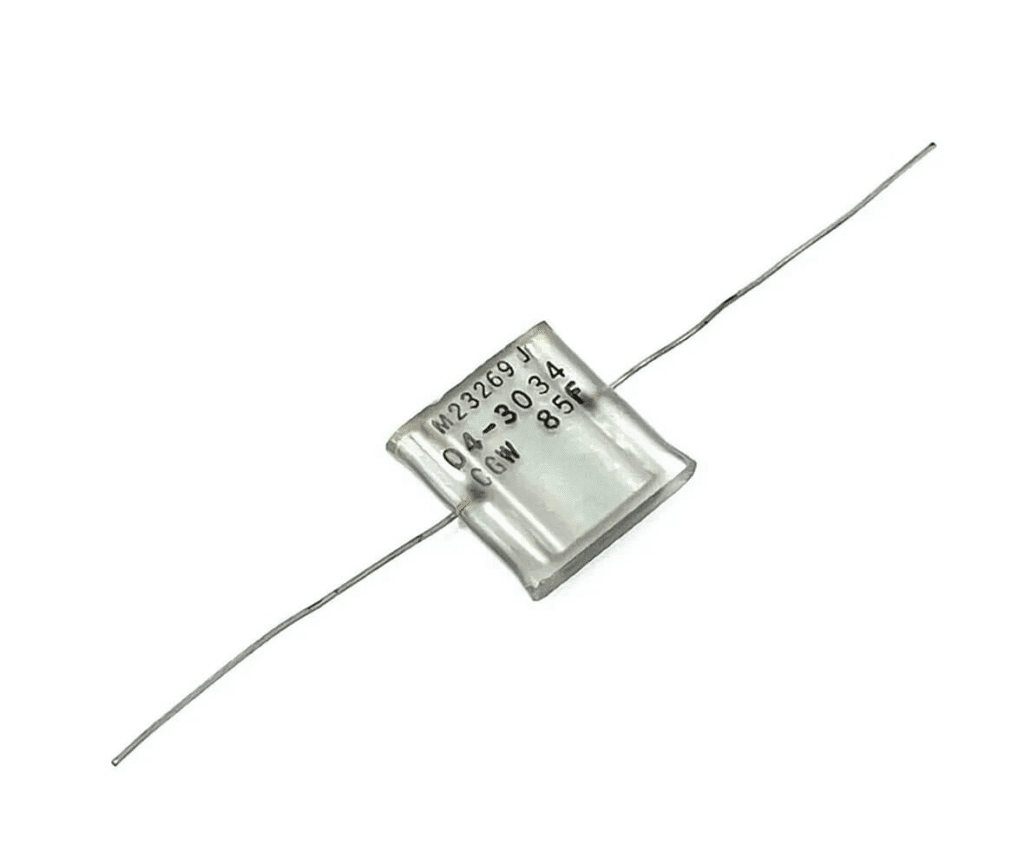
Because they are made to perform perfectly, especially in high-frequency circuits like radio or communication devices, glass capacitors tend to be more expensive than other types. But when you need the best quality and the most reliable performance, they are the right choice.
In short, glass capacitors are small, powerful parts that help make sure electronic devices work smoothly, even in tough environments.
How Does a Non-Polarized Capacitor Work?
A non-polarized capacitor is a special kind of capacitor that can work with electric currents that change direction all the time, like the electricity in your home or in radio signals. Unlike some other capacitors, it doesn’t have a positive or negative side, so it can handle the back-and-forth flow of electricity easily.
These capacitors are often used in circuits that deal with high-frequency signals or where the electricity changes direction very quickly. One common use is in something called an RC spark suppression circuit, which helps reduce annoying sparks or noise in electrical devices.
Imagine when you turn on a fluorescent lamp near your TV or radio. Sometimes, you might hear strange sounds on the radio or see flickers on the TV screen. This happens because small sparks or electrical noise are created when the lamp switches on or off. These sparks send out tiny bursts of energy that interfere with the TV or radio signals.
Inside the TV or radio, there are parts like coils (called inductors) that can cause sparks when the electric current suddenly stops or starts. These sparks create those bright spots or lines you sometimes see on the TV screen.
When the switch labeled ‘S’ is turned off, the electric current stops quickly. Because of this, a strong force is created at both ends of the coil. This force, called electromotive force, tries to keep the current flowing and works against the change in current. The direction of this force matches the voltage applied.
When the two contacts of the switch come very close or touch, the voltage across the switch (called ‘U1’) reaches its highest point.
If the voltage becomes too high, it can jump through the air between the contacts, creating a spark. This spark can cause the contacts to rust or get damaged, which may make the switch stop working properly. So, it’s important to stop the spark from happening.
If the current in the control coil doesn’t drop suddenly, the voltage at the coil ends stays low, and no spark appears.
To prevent the spark, a simple circuit with a resistor (R) and capacitor (C) is connected across the coil. When the switch ‘S’ turns off suddenly, the capacitor starts to charge. The energy stored in the magnetic field of the coil moves into the resistor and capacitor.
Some energy is used up as heat in the resistor, and some is stored in the capacitor as electric energy. Then, the capacitor slowly releases this energy back, which stops the spark from forming between the switch contacts.
Non-Polarized Capacitor vs Polarized Capacitor
Capacitors are tiny electronic parts that store and release electrical energy. But not all capacitors are the same. Some have no “plus” or “minus” side, and some do. Let’s look at how non-polarized and polarized capacitors differ.

Non-Polarized Capacitor:
- This capacitor doesn’t have a positive or negative side. You can connect it in any direction.
- It works well with high-frequency signals.
- It’s often used to let alternating current (AC) pass through while blocking direct current (DC).
- You’ll find non-polarized capacitors made from materials like ceramic, polystyrene, or polyester.
- They can sometimes replace polarized capacitors when needed.
Polarized Capacitor:
- This one has a clear positive (+) and negative (-) side. You must connect it the right way.
- It usually works better at low frequencies.
- Polarized capacitors are great for storing large amounts of energy in small, affordable packages.
- They help smooth out power supplies in devices.
- Common examples are aluminum electrolytic and tantalum capacitors.
- These cannot be swapped with non-polarized capacitors.
Understanding Dielectric in Capacitors
Capacitors store electric energy, and a key part inside them is called the dielectric. The dielectric is like a special material that helps the capacitor hold electricity.
Most capacitors that have polarity (meaning they have a positive and negative side) use a liquid called an electrolyte as their dielectric. This helps them store more electric charge compared to regular capacitors of the same size.
But not all electrolytes are the same. Different kinds can change how much electricity the capacitor can hold. So, even capacitors that look alike can work differently depending on the electrolyte inside.
Another important thing is how much voltage a capacitor can handle without breaking. This mostly depends on the type of dielectric material used. Some capacitors can only work with one direction of electric flow (polarized), while others can work with electricity flowing both ways (non-polarized). The difference comes from whether the dielectric material can handle electricity in both directions or not.
There are many kinds of dielectric materials used in non-polarized capacitors, like metal oxide films and polyester films. These materials are popular because they are reliable and safe for many uses.
Understanding Performance Differences
When it comes to making a TV work well, we need parts that help it perform at its best and meet high demands. One important part is the power supply inside the TV. If the power supply uses a special kind of capacitor called a metal oxide film capacitor as a filter, it has to be just the right size and strength to do its job well.
Because of this, sometimes only a certain type of capacitor called a polarized capacitor can be used in the filter. Polarized capacitors have a positive and a negative side, and you have to connect them the right way—they can’t be reversed.
Electrolytic capacitors, which are usually quite large (above 1 microfarad), help with many jobs inside electronics. They help smooth out power, connect signals, and reduce noise. These capacitors are polarized too.
On the other hand, non-polarized capacitors don’t have a positive or negative side. They are used in things like tuning radios, selecting frequencies, limiting current, and many other uses. Non-polarized capacitors can also be made big and strong to help with special jobs like adjusting power in motors or changing electrical phases.
Understanding Capacitors: Capacity and Shape
Capacitors store electric charge, and even if two capacitors are the same size, they can hold different amounts of charge depending on the material inside them, called the dielectric.
Capacitors come in many shapes and sizes. You might see round ones more often, especially in everyday electronics, while square-shaped ones are less common. Some capacitors look like tubes, flat sheets, or even a mix of shapes, depending on what they are used for.
In devices that work with very fast or medium-speed signals, there are special tiny capacitors called dispersed capacitors. These are small and not easy to see but are very important.
How Different Capacitors Work in Different Places
Capacitors come in many types, and each works best in certain situations.
Polarized capacitors can hold a lot of electric charge because of how they are made inside. But they don’t work well with very fast electrical changes, so they are mostly used in things like power filters, where the electricity is steady. There are special polarized capacitors made from tantalum that handle fast changes better, but these can be quite expensive.
On the other hand, non-polarized capacitors — like ceramic, monolithic, and polyethylene types — are small, affordable, and work great with fast electrical signals. This makes them perfect for high-frequency circuits, such as filters and oscillators. However, they can’t store as much charge as polarized capacitors.
What is the Best Way to Charge a Non-Polarized Capacitor?
A non-polarized capacitor is a special kind of capacitor that doesn’t have a positive or negative side. This means you can connect it to a battery or power source either way—there is no “right” or “wrong” lead to connect first. Unlike polarized capacitors, which have clear markings to show which side is positive and which is negative, non-polarized capacitors don’t have these marks.
So, when you want to charge a non-polarized capacitor using a direct current (DC) power source, you don’t need to worry about which wire goes where. Just connect the capacitor to the power, and it will charge safely no matter which lead you use. This makes them very easy to use in many circuits.
Why Non-Polarized Capacitors Are Great
1. Low Leakage Current
Non-polarized capacitors lose very little electricity when working. This means they waste less power and help circuits run more smoothly, especially when you need a clear, steady signal.
2. Works Well at High Speeds
These capacitors can handle fast changes in electricity, making them perfect for things like radios, computers, and other devices that use quick signals.
3. Works Both Ways
Unlike some capacitors, non-polarized ones don’t care which way the electricity flows. This makes them easy to use in circuits where the direction of current changes, like in many AC devices. It also makes building and fixing circuits simpler.
4. Saves Energy
They don’t need much power to work, which is great for saving energy. You can use them in many different types of electronic devices, whether they run on AC or DC power.
5. Handles Hot and Cold
These capacitors keep working well even when the temperature changes a lot. That means they are reliable in tough places where it can get very hot or very cold.
Downsides of Non-Polarized Capacitors
Non-polarized capacitors have some great uses, but they also come with a few drawbacks:
1. They Can Be Expensive
Big non-polarized capacitors usually cost more because they need special materials and careful making. This can be a problem if you have a tight budget or need many capacitors.
2. Cost vs. Benefits
Because they are pricier, designers sometimes have to think hard about whether the extra cost is worth it. They have to find the right balance between how well the capacitor works and how much money they can spend.
3. Store Less Energy
Compared to polarized capacitors (like electrolytic ones), non-polarized capacitors can hold less energy in the same size. This means they might not be the best choice when you need to store a lot of power, like in energy storage devices or power filters.
4. Can Get Big and Bulky
If you want a capacitor with a large capacity, non-polarized types can become very big or you might need to use many of them. This makes the circuit bigger and harder to manage.
5. Sensitive to Environment
Some non-polarized capacitors, like ceramic or film types, can wear out over time if they are exposed to harsh conditions. This can make them less reliable in the long run.
6. Not Perfect for Low Frequencies
While they work great at high frequencies, some non-polarized capacitors don’t do well at very low frequencies. This can limit their use in certain circuits that need low-frequency performance.
Uses of Non-Polarized Capacitors
Non-polarized capacitors are special because they don’t have a positive or negative side. This makes them very easy to use in many types of circuits. You can connect them in either direction, and they will still work the same way.
Noise Filtering and Circuit Smoothing Made Easy
Non-polarized capacitors are like quiet heroes in the world of electronics. They help remove unwanted noise from circuits — the kind of noise that comes from shaky power supplies or outside signals that sneak in and cause trouble.
Think of them like soft cushions. When the electrical energy gets jumpy or rough, these capacitors catch it, calm it down, and then release it smoothly. This keeps everything running steady and safe.
This is very important in places where even a little bit of noise can cause problems — like in music systems, phones, or computers that send and receive information. These capacitors also play a big role in systems that deal with changing voltages, like machines with motors or areas where the power isn’t stable.
Improve Circuit Current and Voltage
Non-polarized capacitors help control the flow of electricity in a smart and balanced way. They don’t have a fixed direction, which makes them flexible and useful in many situations.
These capacitors store energy for a short time and release it when it’s needed. This helps to keep the current and voltage steady. They are especially helpful in power supplies and motor start-ups.
In power supplies, they act like a buffer. When there’s not enough voltage, they release energy to keep things running smoothly. When there’s too much electricity, they absorb it to protect the circuit. This helps save energy and reduces waste.
Short Circuit Creation and Advanced Functionalities of Non-Polarized Capacitors
Non-polarized capacitors are small but powerful components used in many electronic devices. They’re special because they don’t have a positive or negative side, so they can work in both directions of current flow. Let’s explore how they help us in both basic and advanced ways.
1. Safe Short Circuit for Testing
In some machines, like motor controls, engineers sometimes need to create a short circuit on purpose to test how things react. A non-polarized capacitor can be used here to create a safe and temporary short circuit. This helps in fine-tuning the system without causing damage.
2. Letting AC Signals Through
These capacitors are great at separating AC (alternating current) from DC (direct current). This is called AC coupling. They allow only the AC part of a signal to pass through, which is very helpful in audio systems and signal processing.
3. Shaping Sound and Tone
In music systems or sound equipment, non-polarized capacitors help in tone control. They adjust how high or low certain sounds are, making the audio clearer or more pleasant depending on your needs. This is also called audio equalization.
4. Cleaning Up Power Supply
Electronic devices often face small bursts of unwanted energy called “noise.” These capacitors act like filters. They smooth out the power by removing high-frequency noise and help keep the voltage stable. This is known as power decoupling.
5. Sending Clean Audio Signals
When audio signals move from one amplifier part to another, these capacitors pass the sound while blocking unwanted electricity (DC). This keeps the sound clean and free from disturbances.
6. Protecting Circuits from Sudden Surges
Sometimes, devices face sudden spikes in voltage that can cause damage. Non-polarized capacitors are used in snubber circuits to absorb and control these spikes, keeping the system safe.
7. Tuning and Oscillation
In radios and communication devices, frequencies need to be adjusted just right. These capacitors help with tuning and setting frequencies so the device works consistently and accurately.
8. Timing and Delays
Many machines need actions to happen in a set order or after a short pause. These capacitors help create delays that control the timing of processes — like traffic lights changing colors or machines starting in sequence.
How to Use Non-Polarized Capacitors
Non-polarized capacitors are very easy to use because they don’t have a positive or negative side. This means you can connect them in either direction, and they will still work just fine.
These types of capacitors are great for circuits where the direction of current changes, like in AC (alternating current) systems. Since they don’t care which way the electricity flows, they’re safe and flexible to use.
To connect a non-polarized capacitor, just attach one end to any point in the circuit, and the other end to the other connection point. You don’t have to worry about which side is positive or negative — they work both ways.
Non-polarized capacitors can be used to store electrical energy and then release it when needed. They help in managing the flow of electricity in a circuit, improving its performance and protecting it from damage.
In simple words, if you want a capacitor that is easy to use and doesn’t need special attention to direction, a non-polarized one is the right choice. It’s safe, smart, and reliable.
How to Choose the Right Non-Polarized Capacitors
A simple guide anyone can understand
Choosing the right non-polarized capacitor might seem tricky, but it’s actually pretty simple once you know what to look for. Let’s break it down step by step so you can make the best choice for your project or circuit.
1. Be Accurate, Especially for Sensitive Circuits
If your circuit needs to be very precise—like in audio systems, filters, or timing devices—you’ll want a capacitor that’s very close to the exact value you need. Look for ones with low tolerance (around 0.3% to 0.5%). This means they won’t vary much from the number printed on them, which helps keep your circuit running smoothly and correctly.
For general use, like in basic electronics, a small difference in value is usually fine.
2. Choose the Right Type for the Job
Different types of capacitors work better in different situations:
- Paper capacitors are great for low-frequency work, like simple bypass circuits. They’re cheap and easy to find.
- Ceramic and mica capacitors are better for high-frequency or high-voltage circuits. They’re tougher and more stable in demanding conditions.
3. Match the Voltage Rating
Always pick a capacitor with a voltage rating that’s equal to or higher than the maximum voltage in your circuit. This helps avoid any risk of the capacitor breaking down or even causing damage to your system. It’s all about keeping your circuit safe and reliable.
4. Think About Frequency
If your project involves high frequencies, make sure you’re using a capacitor that’s built for it. A capacitor made for low-frequency tasks won’t perform well here—it might not respond fast enough or could even fail.
5. Check the Temperature and Environment
Capacitors can behave differently depending on the temperature around them. Some are better at handling hot or cold environments than others. Look for one with the right temperature rating and a stable temperature coefficient if your device will face different weather or heat levels.
6. Combine Capacitors if Needed
If you can’t find one capacitor with the exact value you need, don’t worry. You can connect multiple capacitors in series or parallel to reach the right number. Just be careful that the voltage across each one stays within its safe limit. This lets you customize your setup without risking damage.
Troubleshooting Non-Polarized Capacitors (Made Easy)
Non-polarized capacitors are used in many electronic circuits. They’re reliable, but like any electronic part, they can sometimes have problems. Here’s a simple guide to help you understand common issues and how to fix them.
1. Capacitance Changes Over Time (Capacitance Drift)
Some capacitors slowly lose their original value. This can happen because of heat, voltage, or just age. To check, use a capacitance meter and compare the reading to what the part is supposed to be. If the number is too far off, it’s time to replace it. For more stable results, use film capacitors instead of ceramic ones in important circuits.
2. Cracks or Physical Damage
Capacitors can break if they’re dropped, bent, or exposed to too much heat. Look closely—if you see cracks, bulges, or leaks, the capacitor is likely damaged. A broken capacitor can cause other parts of the circuit to stop working. Replace it right away if it looks even a little bit off.
3. Dielectric Breakdown (Short Circuit)
If the voltage in a circuit is too high, it can damage the inside of the capacitor. This is called dielectric breakdown, and it might lead to a short circuit. To avoid this, make sure the capacitor’s voltage rating is higher than the voltage it will face in the circuit. If the capacitor was in a surge or shock, test it or just replace it to be safe.
4. High ESR (Resistance Problem)
Over time, a capacitor may develop high internal resistance (called ESR). This makes it perform poorly, especially in power supply circuits. If your circuit is getting hot or not working right, test the ESR using an ESR meter. If it’s too high, swap the capacitor with a new one that’s better quality.
5. Noise in the Circuit
Some capacitors, especially ceramic ones, can create noise in your circuit. This can happen because they vibrate slightly when power flows through them. If your circuit has noise problems, try using film capacitors instead. Also, double-check that your circuit is grounded well and has good decoupling—this helps reduce noise.
6. Wrong Placement
Even though non-polarized capacitors don’t have a positive or negative side, placing them in the wrong spot on the board can still cause trouble. Make sure they’re installed exactly where they’re supposed to be. This is especially important near parts of the circuit that are sensitive to noise or need extra stability.
Conclusion
Now that we’ve come to the end of our guide on non-polarized capacitors, one thing is clear—they are much more than just small parts in a circuit. These little components are smart and flexible. They don’t worry about which way the electricity flows, and that makes them super useful in many different places.
You’ll find them in everything from your TV and radio to machines used in big factories. Whether it’s keeping sound clean in speakers or making sure power runs smoothly in devices, non-polarized capacitors do their job quietly and reliably.
When you choose a capacitor, just remember to think about what it will do, where it will be used, and what your project really needs. That way, you’ll always make the best choice.
FAQ
I am an Electrical Engineer with qualifications in ITI, Diploma, and B.Tech. I have worked as an ITI college instructor for 3 years and have over 5 years of hands-on experience in the electrical field. The information shared on this website is based on trusted electrical engineering textbooks such as P.S. Bimbhra, B.L. Theraja, V.K. Mehta, and real-world practical experience.

